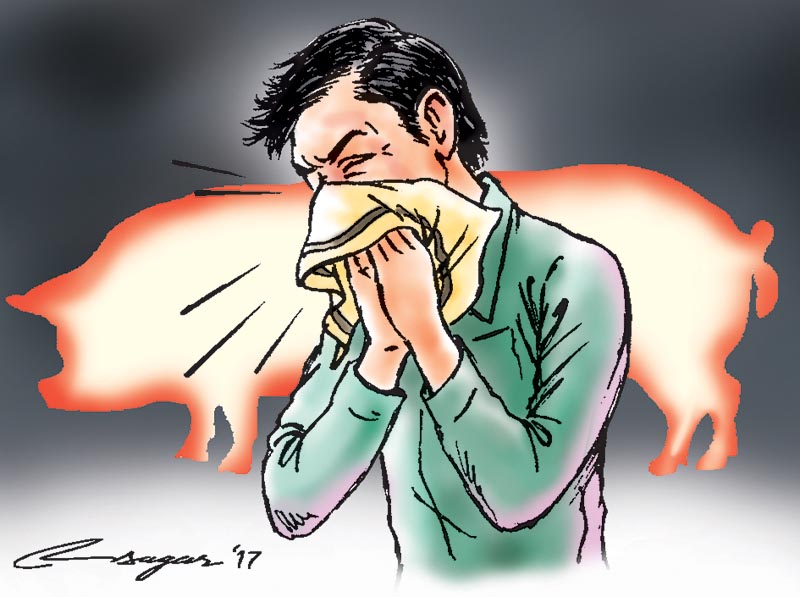Swine flu panic: Precautionary measures
Doctors and the general public are not yet well aware of the benefits of using vaccination against swine flu. Vaccines must be given before the flu season begins. The government, thus, must first determine flu seasons in Nepal, and then recommend immunization schedule
Nepal is now witnessing a sudden surge in the number of swine flu cases over the past few days and at least 6 people reportedly died after contracting swine flu virus within a one-week period. These are the first reported swine flu death cases in Nepal this year, though we have been detecting this virus since the last week of June. Swine flu refers to influenza A(H1N1) pdm09. Swine flu usually epidemics during rainy and late winter season in Nepal. Swine flu virus, however, did not appear to be the main cause of Influenza like the illness epidemic last year. Nowadays, people are panicking over the sudden and rapid spread of swine flu virus in Nepal.
Since the beginning of 2017, at least 600 people have succumbed to swine flu, while more than 13,000 people are affected across India. The mortality rate of swine flu in India is nearly 4.6%. It is estimated that millions of people cross the Nepal-India border every single day due to its 1,800 km long open border. The open border can lead to the rapid spread of communicable diseases, including swine flu. The current swine flu outbreak in Myagdi and Kathmandu may also have been imported from India, though virus analysis is yet to be done to confirm or refute this hypothesis. Not only land border but airport screening needs to be more effective to identify suspected swine flu cases to prevent or delay their entry into the country.
Nepal government should set a clear vision about how and where (which hospital) to transfer, if they suspect flu virus case (including other highly contagious infectious diseases) at a port of entry. Sometime ago, Nepal government asked major hospitals in the capital to set up isolation wards in order to manage highly infectious diseases.
Nepal should establish its own diagnostic laboratories that are capable of identifying and tracking emerging influenza strains that may have been circulating or will have circulated in Nepal. This will be helpful in determining the patient’s prognosis and selecting vaccine candidates for high-risk groups.
At least four doctors at the Postgraduate Institute of Medical Education and Research (PGIMER), India, have been found to be infected with swine flu virus. Although they are stable, it shows that healthcare workers are at risk of contracting this virus. The PGIMER has now already instructed all its healthcare workers to be vaccinated against this virus. In Nepal, so far, such incidents have not been thought of, and thus all healthcare workers are at risk of getting swine flu virus. Most healthcare workers are treating their patients without wearing masks, and sometimes even without wearing white aprons that increases the risk of acquiring infectious diseases.
Nepal government usually reacts only after active outbreaks of infectious diseases have occurred. Swine flu was first detected in late June this year, however, until the fatal cases were reported, the concerned bodies did not campaign against swine flu in between this period. These swine flu death cases could have been averted, if they were alerted, oriented about this virus, and necessary precautionary measures were taken up. Precautionary measures include frequent hand washing, coughs and sneezing into upper arms, avoiding a handshake but instead preferring “NAMASTE”, and keeping a distance of at least one meter from people with cold or suspected having swine flu. High-grade fever, headache, dry cough, sore throat, breathing difficulty, diarrhea and vomiting particularly in children are major symptoms of swine flu. Laboratory testing is necessary in order to confirm this virus.
Currently, National Public Health offers this facility in Nepal, and performs at no cost. Oseltamivir is the drug of choice for treatment of swine flu and is effective if it is taken within 48 hours of symptoms onset. It is nonetheless not readily available in the market. Until now, Nepal government has been providing this antiviral drug free of cost. Nepal government offers this antiviral drug to those infected people who belong to high-risk groups. Children under the age of 2 years, people 65 years and older, patients with chronic diseases such as asthma, chronic obstructive pulmonary disease, heart disease, liver or kidney disease, HIV/AIDS, and women who are pregnant are considered to be in the increased risk group of developing flu related complications.
The best option to avoid swine flu related complications is to get vaccinated each year. In Nepal, neither physicians nor policy makers are familiar with swine flu vaccine. In my experience, only a few doctors have encouraged their patients to receive the vaccination against swine flu in the past. It shows that doctors and the general public are not yet well aware of the benefits of using vaccination against swine flu. Vaccines must be given before the flu season begins. The government, thus, must first determine flu seasons in Nepal, and then recommend immunization schedule.
To sum up, although there is no need to panic over the current swine flu epidemic, we must stay up to date about the source and spread of this virus, and its nature in order to reduce/minimize swine flu associated deaths in Nepal.
Pun is Coordinator of the Clinical Research Unit, Sukraraj Tropical & Infectious Disease Hospital






